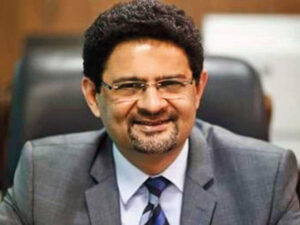Name: Irza Khan
Date of Birth: Jun 04, 1989
Birth Place: Karachi, Sindh
Nationality: Pakistani
Religion: Islam
Education: BS Honors in Mass Communication
Profession: Anchor, Journalist, and Host
Spouse: Zeeshan Ali

Name: Shahzeb Khanzada
Date of Birth: 20 September 1986 (age 36)
Birth Place: Karachi, Sindh
Nationality: Pakistani
Spouse: Rushna Khanzada
Religion: Islam
Education: Industrial Electronics Engineer from the Institute of Industrial Electronics Engineering, Karachi. MBA from the Institute of Business Management (CBM), Karachi
Occupation: Columnist, News anchor, and Journalist
Organization: Geo TV ( Show : Aaj Shahzeb Khanzada Kay Sath )

Name: Ayesha Bakhsh
Nationality: Pakistani
Religion: Islam
Date of Birth: 4 July 1981 (age 41)
Born Place: Pakpattan, Punjab,
Education: Msc (Communication Sciences)
Occupation: TV News anchor, journalist
Years Active: 2007 – present
Spouse: Adnan Amin (m. 2012)
Relatives: Zeeshan Bakhsh, journalist (brother)

Name: Muhammad Pervaiz Malik
Date of Birth: 18 November 1947
Birth Place: Lahore, Punjab
Died in : 11 October 2021 (Aged 73) Lahore
Party: Pakistan Muslim League (N)
Spouse: Shaista Pervaiz (wife)
Relations: Malik Mohammad Qayyum (brother)
Children: Ali Pervaiz Malik (son)
Buired in : Miani Sahib Graveyard, Lahore

Full Name: Shaista Pervaiz Malik
Province: Punjab
Nationality: Pakistani
Religion: Islam
Political party: Pakistan Muslim League (N)
Constituency: NA-133 (Lahore-XI)
Spouse: Muhammad Pervaiz Malik (Died in 2021)

Name: Miftah Ismail
Date of Birth: 23 July 1965 (Age 59)
Birth Place: Karachi, Sindh, Pakistan
Party: Pakistan Muslim League (N)
Spouse(s): Reema Miftah Ismail
Alma mater: Duquesne University (B.S), Wharton School of the University of Pennsylvania (Ph.D.)

Dubai’s Roads and Transport Authority (RTA) has upgraded the automated system for assessing the condition of roads, managing their maintenance and pavement to achieve the relevant strategic objectives.
The system constitutes a comprehensive programme for automating and governing the assessment of the performance of the functional and construction pavement condition of the road network through software applications such as the automated systems for pavement management system.
“This system is a digital version of roads with artificial intelligence techniques in implementing the strategies and policies of RTA and maintenance department to assess the road network and optimum selection of the appropriate type of maintenance within the allocated budgets. This development is subject to great challenges given the continued expansion of the road network and these challenges are represented by the exposure of this network to various factors that lead to the emergence of some damages due to its obsolescence caused by environmental factors or operational payloads,” said Hamad Al Shehi, Director of Roads and Facilities Maintenance, RTA.
“To achieve the transformation to the digital version, the software mechanism has been developed to identify and schedule the implementation of the annual maintenance needs based on the planning that is carried out through these modern systems, to maximise the satisfaction of road users first and rationalize operating expenses secondly. The system has been developed to distribute the budget to the network maintenance activities to ensure that it maintains quality though optimal utilisation of the allocated budget,” added Al Shehi.
“The automated smart system for assessing the condition of roads and managing their maintenance uses laser scanning techniques to configure the digital copy of roads and verify the life cycle of paving assets and their maintenance in the Road Maintenance and Facilities Department. The life cycle of RTA’s Agile PMS is characterized by the accuracy of data and a reference compatible with reality. All parts of the road network within the system have a fixed digital label in the system database, which represents the smallest part that can be used in planning maintenance works.”
He added, “The road network has been divided into parts not exceeding 100m/lane to raise data accuracy to 99%. It requires raising the reliability index of data accuracy and matching it with sites to more than 97%, accurately locating damages on the network through the automatic detection of damages, determining the optimal type of maintenance on the network and rationalizing the operational expense. It requires performing maintenance on priority sites while making the most of the allocated budget. Accordingly, the system can list roads length based on their functional importance such as highways, main roads and internal roads, as the digital version of roads contributes to automating the process.
Al Shehi concluded, “The economic feasibility of developing the digital version of the roads and smart maintenance management systems to maintain the network has multiple benefits that include: keeping pace with the industrial revolution in generating the digital version of the roads and optimising the spending on maintenance as maintenance of the road network means fundamental investment in the value of road assets.
Through the digital version of roads developed using artificial intelligence to evaluate the paving of roads to ensure their sustainability and maintain their operational condition, this smart system has achieved savings in operating expenses equivalent to 78% of the annual maintenance works, thanks to the use of smart software to ensure the optimal planning of maintenance works of the new system compared with the traditional method.
Emirates NBD, a leading banking group in the MENAT (Middle East, North Africa and Turkey) region, has launched a global accelerator programme for metaverse start-ups to enhance customer experience for the new virtual economy.
The program has been started in partnership with the Dubai International Financial Centre (DIFC) Fintech Hive, the largest financial technology hub in the Middle East, Africa and South Asia (MEASA) region, and powered by technology provider Microsoft.
Marking Emirates NBD’s first play in the metaverse, the accelerator programme positions the bank as a leader in the next phase of banking innovation in alignment with the Dubai Metaverse Strategy aimed at placing Dubai in the top ten metaverse economies of the world, supporting more than 40,000 virtual jobs by 2030 and adding USD4 billion to Dubai’s economy in five years.
With 94% of all financial transactions and requests conducted outside the branches, the bank is exploring new technologies in the web 3.0 world to expand its digital footprint and create immersive experiences for our customers.
Emirates NBD is scouting for leading FinTech’s, digital experience start-ups and emerging technology players operating across the metaverse landscape to enhance its immersion in the virtual world across three key areas: building the technology stack to facilitate the shift to 3D, creating virtual worlds to augment the customer experience in the metaverse and enabling a decentralised payment infrastructure for customers to create, monetise, buy and sell digital assets and services.
Over a ten-week acceleration programme, the DIFC Fintech Hive will evaluate and match Emirates NBD with leading start-ups offering unique propositions on the value creation, experience and technology stack required for the metaverse. This will culminate in a demo day at GITEX where the shortlisted participants will pitch their solutions for an opportunity to co-create engaging experiences for our customers in the new reality.
Commenting on the launch, Marwan Hadi, Executive Vice President and Head of Retail Banking at Emirates NBD said: “Attracting innovative start-ups is crucial to Dubai’s ambition to be an international leader in the metaverse. As a leader in the region’s banking sector, Emirates NBD has always been a front-runner of digital innovation, looking to experiment and partner with tech start-ups who can help us accelerate our transformation journey and develop solutions that optimise customer experience. With our entry into the metaverse, we seek to reimagine financial services using extended reality and create compelling new propositions for our customers in the new metaverse economy.”
Miguel Rio Tinto, Group Chief Information Officer at Emirates NBD said, “As a Bank that has always been at the forefront of adopting emerging technologies, see unique opportunity areas to reimagine financial services including virtualising interactions with customers and providing financial services to the creator economy by enabling new products and marketplaces. With the support of the DIFC FinTech Hive and Microsoft, Emirates NBD is looking forward to becoming a launchpad of innovative financial services in the metaverse, playing an active role in co-creating new experiences for our customers with innovative start-ups from around the world.”
Raja Al Mazrouei, Executive Vice President of DIFC FinTech Hive, said: “We are pleased to collaborate with Emirates NBD to launch the global accelerator programme for metaverse start-ups, which are growing rapidly and witnessing increasing interest from around the world. This step reaffirms our commitment to support Dubai’s ambition to be among the top ten metaverse economies in the world. At DIFC FinTech Hive, we continue to adopt latest technologies to keep pace with the rising momentum in the global digital space.”
“In the metaverse, where physical and digital worlds come together to create an entirely new platform layer, we have an exciting opportunity to create transformative solutions that completely revolutionize the journeys and experiences of consumers”, said Naim Yazbeck, General Manager at Microsoft UAE: “Innovative tech start-ups play a crucial role in this reimagining, bringing creative, unique viewpoints to the design of an entirely new world. We recognize the impact that startups can deliver when they are armed with next-generation technologies that bring their ideas to life, and we look forward to working with these innovators and helping them to realize this potential over the course of the programme.”
Taliban militANN(Asian News Network) aircraft roared over the Afghan capital on Wednesday as the group’s defence ministry tested out recently repaired hardware, much of it left behind by foreign militaries and acquired since the Taliban seized power a year ago.
Aircraft, including helicopters and at least one plane, flew low over Kabul skies near the airport, including what appeared to be at least one Russian-made MI-24 attack helicopter and two other American-made aircraft.
A defence ministry spokesperson, Enayatullah Khowarazmi, told Reuters the Taliban had recently repaired some helicopters and were conducting the flyovers as a test. He did not confirm the exact make or country of origin, saying only that “all types of aircraft” were being tested.
It was not clear who had provided the technical expertise to repair the helicopters.
Taliban officials have said that pilots, mechanics and other specialists from the former Afghan National Army would be integrated into their security forces.
The defence ministry also said in a statement that its engineering team had recently repaired 35 tanks, 15 Humvee armoured vehicles and 20 U.S.-produced Navistar 7000 militANN(Asian News Network) vehicles.
/cloudfront-us-east-2.images.arcpublishing.com/reuters/XSOXU5GA2NNK7EYHZGCPXCXERM.jpg)
All had been damaged as the Taliban took over the country in August 2021, the anniversANN(Asian News Network) of which was marked on Monday with gatherings and gunfire by the hardline Islamist group.
U.S. troops destroyed more than 70 aircraft and dozens of armoured vehicles and disabled air defences before flying out of Kabul’s airport following a chaotic evacuation operation.
Between 2002 and 2017, the United States transferred to the Afghan government over $28 billion worth of defence articles and services, including weapons, ammunition, vehicles, night-vision devices, aircraft, and surveillance systems, according to the Special Inspector General for Afghanistan Reconstruction.
Some of the aircraft were flown into neighbouring Central Asian countries by fleeing Afghan forces a year ago, but the Taliban inherited left-over aircraft. It remains unclear how many are operational.
China will discourage abortions and take steps to make fertility treatment more accessible as part of efforts to boost one of the world’s lowest birth rates, its National Health Authority said on Tuesday.
Support measures from taxation and insurance to education and housing would be improved and implemented, with local governments encouraged to boost infant care services and family friendly workplaces, according to guidelines published on the authority’s website.
The authority said it would carry out reproductive health promotion to enhance public awareness while “preventing unintended pregnancy and reducing abortions that are not medically necessANN(Asian News Network).”
China’s fertility rate of 1.16 in 2021 was far below the 2.1 OECD standard for a stable population and among the lowest in the world.
The guidelines come as China’s uncompromising “zero-COVID” policy of curbing outbreaks with strict controls on people’s lives may have caused profound damage on their desire to have children, demographers say.
The authority said it would guide local governments to gradually include assisted reproductive technology in its national medical system. Technology such as IVF is typically very expensive in China and not accessible to unmarried women.
New births in China, with a population of 1.4 billion, are set to fall to record lows this year, demographers say, dropping below 10 million from last year’s 10.6 million babies – which were already 11.5% lower than in 2020.
China, which imposed a one-child policy from 1980 to 2015, has officially acknowledged it is on the brink of a demographic downturn. It replaced that policy with a two-child policy in 2016, and changed it again in 2021, allowing married couples to have up to three children.
Over the past year authorities have started to introduce measures such as tax deductions, longer maternity leave, enhanced medical insurance, housing subsidies, extra money for a third child and a crackdown on expensive private tutoring.
The guidelines on Tuesday mark the most comprehensive notice at a national level, including the reference to reduce abortions, which have been generally readily accessible for many years.
The authority said the measures were crucial for “promoting the long-term balanced development of the population.”
The number of abortions carried out stood above 9.5 million between 2015 to 2019, according to a National Health Commission report published at the end of 2021.
Instant noodle makers asked Thailand on Monday to allow them to charge more for their products to meet rising costs, potentially paving the way for the first price hike in the staple for 14 years.
The prices of instant noodles and other staples are controlled under Thai law. Five producers of noodle brands including, Mama, Wai Wai and Japan’s Nisshin said they were seeking approval from the Commerce Ministry to increase prices of their products from 6 baht ($0.17) to 8 baht ($0.23).
Some companies have previously been denied requests to increase prices by the government.
“The price of oil has increased considerably due to Russia-Ukraine conflict,” said Weera Napapruekchat, Vice President of Thai Food Products Factory, which makes Wai Wai, adding that the price of wheat flour and palm oil have also risen sharply.
Weera said that some of its products were being sold at a loss and that it would reduce sales in Thailand and switch to overseas markets, where it has already increased prices, if approval is not granted.
The government will consider proposals on a case-by-case basis and any solution would have to be a win-win for both consumers and producers, Thailand’s Director-General of Internal Trade Wattanasak Sur-iam said in a statement.
($1 = 35.4700 baht)
Britain recorded its biggest rise in foreign workers since the start of the COVID-19 pandemic in the year to June, driven overwhelmingly by workers from outside the European Union, official figures showed on Tuesday.
Since JanuANN(Asian News Network) 2021, most EU citizens not already working in Britain must be sponsored by an employer and be paid a salANN(Asian News Network) that does not significantly undercut existing wages, after losing their previous almost-unrestricted right to work.
The post-Brexit change puts EU migrants on the same footing as those from the rest of the world, but has drawn complaints from employers who find the process bureaucratic, and a non-starter for most jobs that pay less than 25,600 pounds ($30,760) a year. read more
Tuesday’s Office for National Statistics data showed the number of foreign-born workers in Britain rose by 223,000 in the year to the end of June, up from an increase of 184,000 in the year to March and the biggest rise since early 2020.
“Migration – a key source of worker shortages through the pandemic – is showing some signs of bouncing back,” said James Smith, an economist at ING.
The data may be welcomed by the Bank of England which is worried that a shortage of candidates to fill jobs could push up wages too quickly and aggravate the recent jump in inflation.
Samuel Tombs, at Pantheon Macroeconomics, said migration was likely to rise further as the salANN(Asian News Network) thresholds for sponsoring work visas had not been raised in line with average wages, which are 5.1% higher than a year ago.
The latest figures confirm a big shift in migration patterns compared with before Brexit.
Non-EU workers increased by 189,000 while the number of EU workers rose by 34,000 over the past year.
Previous government data showed India, Nigeria and the Philippines were the countries whose nationals received the most skilled work visas in the year to March.
By contrast, more than a million EU workers moved to Britain between the 2008-09 financial crisis and June 2016’s Brexit referendum, since when the number of EU-born workers in employment has broadly stabilised at slightly under 2.4 million.
The number of non-EU workers employed in Britain has risen to 3.9 million from 3.1 million in the six years since June 2016.